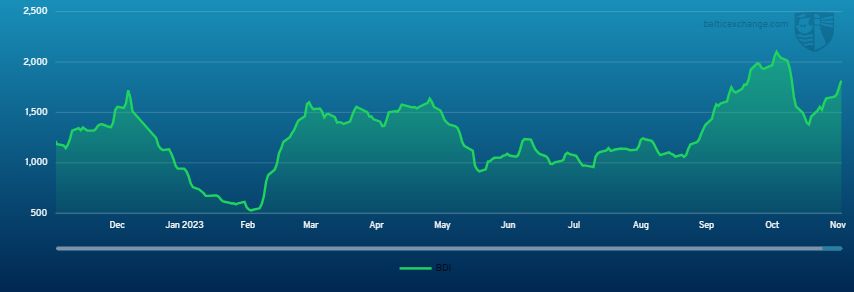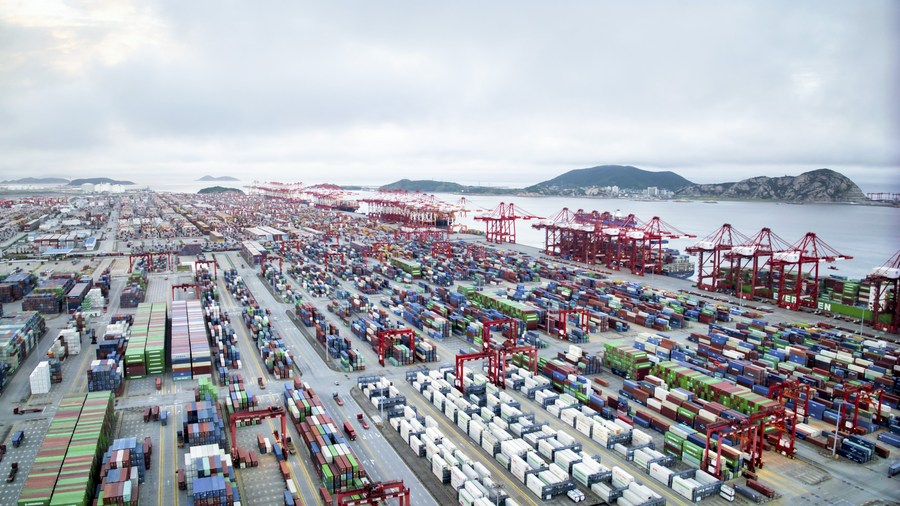BEIJING, Nov. 21 (Xinhua) -- The Baltic Exchange has published its weekly report of the dry and tanker markets for November 13-17, 2023 as below:
Capesize
The week commenced with a subdued market due to Singapore's Diwali holiday. However, the Pacific region saw a positive turn on Tuesday, marked by increased trading volumes and improved fixtures on C5, supported by a solid volume of coal cargoes. The midweek surge continued in the Pacific, driven by Japanese tender cargoes and heightened coal shipments from east coast Australia and Indonesia, resulting in a further 40-cent increase on C5. Meanwhile, the Atlantic market witnessed notable activity, especially from southern Brazil and West Africa. Towards the end of the week, the Pacific market maintained the positive momentum. Brokers talked of some port closures in China caused by strong winds potentially causing delays, however, with all three miners actively participating there were further gains. Meanwhile, the Atlantic region sustained its optimistic outlook, with firm fixtures and an upward climb in the C3 index, which gained over $2 to close at $22.589. Overall, the week saw dynamic market conditions, with the Pacific region driving increased activity and positive sentiment persists in the Atlantic.
Panamax
A dramatic week for the Panamax market, chiefly in the Atlantic with rates accelerating sharply. The north of the arena appeared mostly mineral centric but stable grain demand was seen too ex US Gulf and NC South America. This was coupled with a highly firm market ex US Gulf for the Supramax and Ultramax sectors, lending support to the remarkable moves seen in the market. Quick Baltic round trips were achieving $30,000 by the end of the week, with longer trans-Atlantic trips now in the low $20,000s, with some voyage business edging closer to mid $20,000s on an equivalent basis. Whilst rate increases were less spectacular in Asia than the Atlantic, a solid week for the basin saw solid levels of demand predominantly mineral led ex Australia and Indonesia. Multiple short period up to one-year deals concluded this week. The one-year mark averaging out around the low-mid $14,000s mark for 82,000dwt types delivery to the Far East.
Ultramax/Supramax
A stronger week than recent weeks, with better levels of enquiry and a tightening of prompt tonnage from key areas. The Atlantic was led from the US Gulf where demand was very strong, certainly for fronthaul trips. A 63,500dwt was heard fixed for a trip from Pascagoula to India with petcoke at $47,500, whilst another Ultramax was heard to have fixed a trans-Atlantic run from the US Gulf at $32,000. There was also a bit more interest from the South Atlantic and again rates seemed to be on an upward trajectory. From Asia, a more positive feel as fresh enquiry from Indonesia led to a reduction of prompt tonnage availability. A 58,000dwt was heard fixed delivery Singapore for a trip via Indonesia redelivery China at $15,000. Further north, a 56,000dwt was fixed basis delivery China for a steals run to SE Asia in the mid $6,000s. On the period front, a 63,000dwt open Haldia was heard to have been extended in direct continuation for 12 months trading at $14,000.
Handysize
Positivity swept back into the Atlantic this week, helping guide the BHSI to an upward trajectory after a sustained period of decline. The US Gulf was said to be lacking tonnage availability and charterers had begun to source tonnage from Europe and West Africa to cover their requirements. The Continent and the Black Sea had shown improvements in levels of fresh enquiry in recent days with rumours of a large handy fixing from the Continent to the US Gulf at around $13,000 but further details had yet to surface. In northern Brazil, levels had also improved for owners, with a 40,000dwt fixed from North Brazil to Norway at $17,500 in the early part of the week, whilst a 34,000dwt fixed from Itaqui to Singapore-Japan in the high teens. In Asia, activity was still said to be subdued in general but brokers spoke of the first signs of positivity creeping into some regions as levels of fresh enquiry had improved.
Clean
LR2
LR’s in the MEG have been subject to some further testing down this week. The 75Kt MEG/Japan TC1 index lost another 11.39 points to WS123.89 where it looks to have plateaued for the moment. The 90kt MEG/UK-Continent TC20 run to the UK-Continent also devalued to the tune of $306,000 to $3.44m.
West of Suez, Mediterranean/East LR2’s on TC15 revitalised this week from some activity in the market. The index hopped up from $3.22m to $3.57m.
LR1
In the MEG, LR1 freight levels dipped again this week in line with their larger siblings. The 55kt MEG/Japan index of TC5 dropped from WS140.31 to WS132.5 where it appears to have stabilised for now and the 65kt MEG/UK-Continent of TC8 is currently pegged at $2.96m.
On the UK-Continent, the 60Kt ARA/West Africa TC16 index, pushed up and optimistic 15.31 points this week to WS187.81. This took Baltic TCE for the run up over the $40,000/day round trip.
MR
MR’s in the MEG had a small resurgence this week. The 35kt MEG/East Africa TC17 index, climbed just under seven points to WS209.29.
UK-Continent MR’s continued on their downward trend this week. The 37kt ARA/US-Atlantic coast of TC2 dropped too WS186.5 from WS200. Similarly TC19 (37kt ARA/West Africa) lost 9.88 points to be currently marked at WS200.75.
The USG MR’s powered on upwards this week, driven by consistently high demand. TC14 (38kt US-Gulf/UK-Continent) jumped up another 66.79 points to WS211.43 seeing the Baltic TCE for the run nearly double to $28,000/day round trip. The 38kt US Gulf/Brazil on TC18 added 27% to its value from last week with it currently at WS301.43 and a 38kt US-Gulf/Caribbean TC21 trip pumped up another 39% this week to $1.44m.
The MR Atlantic Triangulation Basket TCE climbed for the fourth week from $34,227 to $44,856.
Handymax
In the Mediterranean, Handymax’s had another upturn this week reflected in the TC6 index hopping up 41.67 points to WS266.67.
In Northwest Europe, the TC23 30kt Cross UK-Continent remained settled in the mid WS160’s.
VLCC
The market rebounded this week. The rate for 270,000 mt Middle East Gulf to China rose seven points to WS74.04, which corresponds to a daily round-trip TCE of $54,787 basis the Baltic Exchange’s vessel description. The 280,000 mt Middle East Gulf to US Gulf trip (via the cape/cape routing) is now assessed two points higher at WS38.25.
In the Atlantic market, the rate for 260,000 mt West Africa/China climbed a little over five points to WS72.10 (which shows a round voyage TCE of $52,249/day), while the rate for 270,000 mt US Gulf/China is $172,222 stronger than a week ago, at $10,177,778 ($45,749/day round trip TCE).
Suezmax
Suezmaxes in West Africa had another week of softening returns. The rate for 130,000 mt Nigeria/UK Continent fell a further seven points to WS98.86 (a daily round-trip TCE of $36,179). In the Mediterranean and Black Sea region the 135,000 mt CPC/Med route dropped about 15 points to WS137.90 (showing a daily TCE of $66,918 round-trip). In the Middle East, the rate for 140,000 mt Middle East Gulf to the Mediterranean slipped almost three points to WS75.
Aframax
In the North Sea, the rate for the 80,000 mt Cross-UK Continent route has been reduced by another 15 points to WS180 (showing a round-trip daily TCE of $75,724 basis Hound Point to Wilhelmshaven). In the Mediterranean market, the rate for 80,000 mt Cross-Mediterranean has had another poor week, coming off 37 points to WS196.89 (basis Ceyhan to Lavera to show a daily round trip TCE of $49,735).
On the other side of the Atlantic, charterers have been able to lower the market again, while owners are unable, at the moment, to stem to tide. The rate for 70,000 mt East Coast Mexico/US Gulf (TD26) is 29 points lower than a week ago at WS252.50 (a daily round-trip TCE of $81,912) while the 70,000 mt Covenas/US Gulf rate has been reduced 26 points to WS236.25 (a round-trip TCE of $69,182/day). The rate for the trans-Atlantic route of 70,000 mt US Gulf/UK Continent has shed a further 12.5 points week-on-week to WS207.50 (a round trip TCE basis Houston/Rotterdam of $55,792/day).
LNG
Despite reports of a relatively active spot market, with requirements being shown ex-Australia and the Middle East, as well as some FOB ex-US, there is little uptick in the spot rates. One of the stumbling blocks facing an uptick in rates is that charterers are having a hard time pinning down cold/modern/open ships, with utilisation of fleets from major players coming first and foremost, while the ships in the market are not always fit for the cargoes shown. Rates, as a result, have been flat, with BLNG1g Aus-Japan moving by the smallest of margins gaining just $15 on the week to close at $146,657. BLNG2g Houston-Cont was a little more bearish shaving $4,820 off the start of the week to finish at $155,434, while BLNG3g Houston-Japan fell a little more to close at $166,864.
Some brokers reported that a TFDE 155cbm vessel fixed for a voyage in the east at $150,000 PD, which could bolster rates next week. However, with sentiment very much the defining factor of the LNG market, there could be status quo. Certainly the uproar of the winter market from previous years seem a distant memory.
LNG period has softened further with rates now on a one-year 174 2-Stroke ship published at $102,733, down around $1,100 from the week previous. Reports of longer-term business is rumoured but with discussions held privately little has emerged to drive levels.
LPG
The market out in the East has been relatively stable. Some cargoes going on subs at the tail end of the week around $150 has pushed rates up and the index rose by $5.142 on the week to close at $152.571, giving a daily TCE earning of $140,730. There is the beginning of a false narrative on the tonnage list though while concern still lingers on the possibility of hefty delays, or even heftier auction slots, to go through the Panama Canal many ships in the AG available for BLPG1 trade are enroute to the US to look for BLPG3 and BLPG2 cargoes.
This is making position lists quite trying for brokers at the moment. Ships with itineraries going through the Panama Canal are uncertain, and Neo ships versus Panama ships are trading at quite a premium. Tonnage coming from the Middle East could be snapped up locally or all move across the Atlantic and change the outlook there. How this may affect the rates is not well known yet. Rates were flat for Houston-Chiba at the start of the week, losing some steam and dropping over $2 before an end of week rally where rates ended up $2.715 overall and at a value of $240.286, giving a daily TCE earning at $146,304. Houston-Flushing BLPG2 was more subdued rising little to close at $134.8 with a TCE earning equivalent of $164,719.
Headquartered in London and a subsidiary of the Singapore Exchange (SGX), the Baltic Exchange publishes a range of indices and assessments which provide an accurate and independent benchmark of the cost of transporting commodities and goods by sea. These include the Baltic Dry Index (BDI), the dry bulk shipping industry's best known indicator. Published daily since 1985, this provides a snapshot of the daily spot market earnings of capesize, panamax and supramax vessel types on the world's key trading routes.

Chart shows Baltic Dry Index (BDI) during Nov. 18, 2022 to Nov. 17, 2023

Baltic Forward Assessment for BDI
In March 2018 the BDI was re-weighted and is published using the following ratios of time charter assessments: 40 percent capesize, 30 percent panamax and 30 percent supramax. The information is provided by a panel of international shipbrokers.
(Source: The Baltic Exchange, edited by Niu Huizhe with Xinhua Silk Road, niuhuizhe@xinhua.org)




 A single purchase
A single purchase









